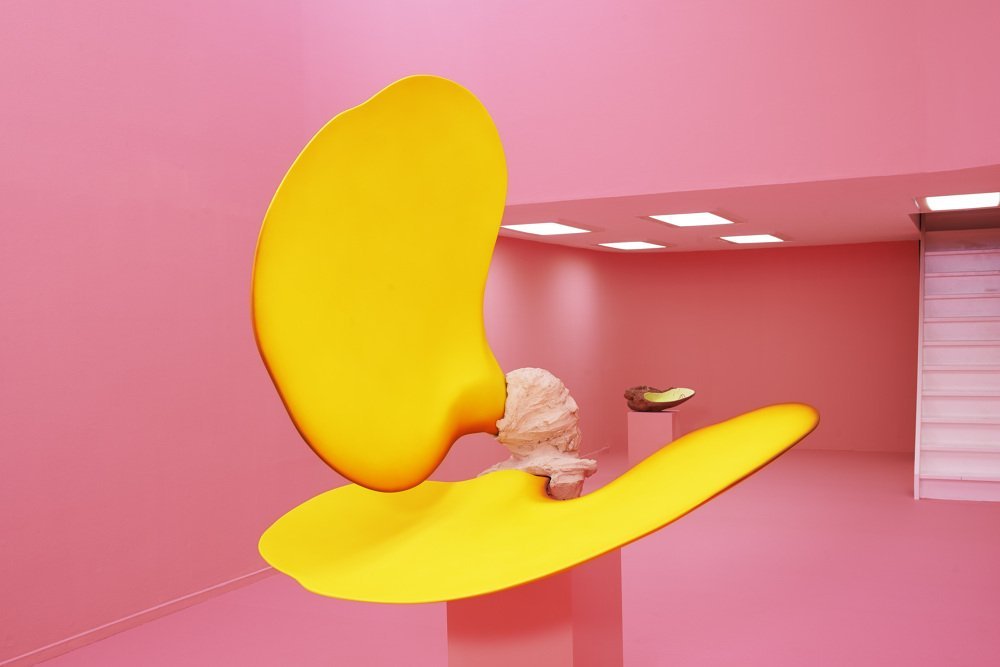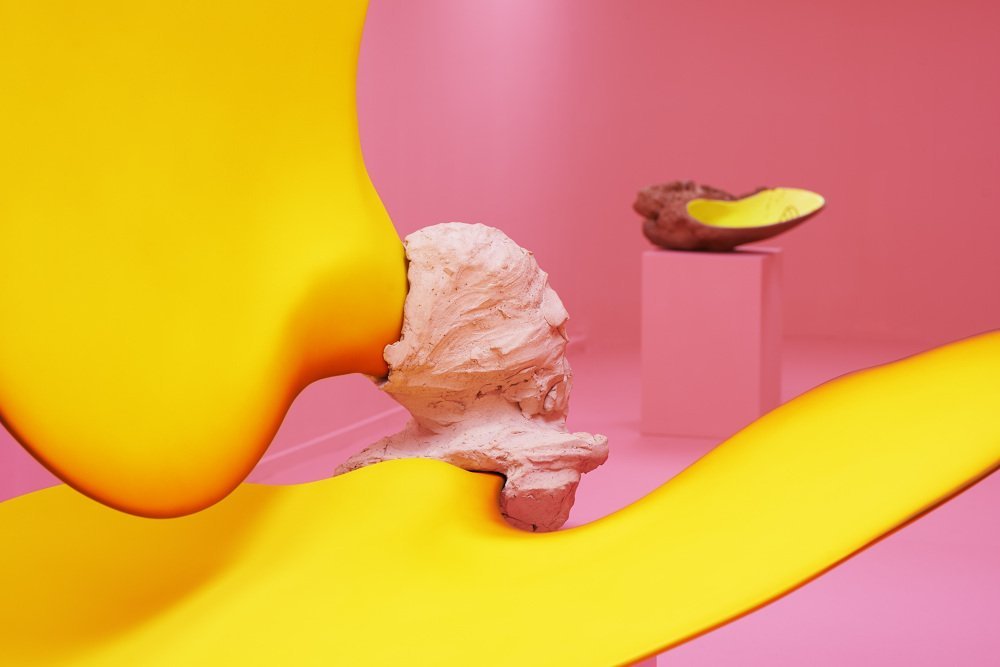On first glance at these objects I was oddly uninterested. Despite their significant scale, contrasting natural and lurid colours, juxtaposition of handmade and synthetic elements, my brain just kind of went “oh yes, it’s art.” I was more interested in Franz West and Phyllida Barlow, whose work in this seemed to embody such a sense of threat and play. (A quick sidebar: the wall text claims that West’s Epiphanie an Stühlen (2011) is such fun; however to me it’s a kind of uniformly-coloured global nuclear war or virus, with absence evoked by two empty chairs - just because it’s pink doesn’t make it not disturbing.) By comparison, Abboud’s Tunnel Boring Machines seemed very ‘finished’ - somehow not requiring me to view them to be ‘completed’ (Eco, 1989.)
I attended the artist talk, though, and on second look my view completely changed. Abboud explained that collage was crucial to her process; a sense of removing hierarchies of scale, time and subject-matter, so that all elements have the same importance. In a collage she showed us, the elements were linked by the idea of ‘a sense of a mouth, that things are coming out of something,’ an equivalence is drawn as a ‘flower comes out of a worm out of a volcano out of a Wind God out of a shark.’
Combined with this is a particular approach to material. She says that she is somehow unable to escape the tactility and the metaphoric capacity of clay; primary among which are the strata and the underground, which we step on, extract, drill and cross every day - but generally remains unfathomable and unknown. Alongside this the synthetic material; weird fins, or surfboards, but also like lava, or some kind of language, or a disgusting anenome/worm. The clay ‘husk’ has these kind of oozing, hybrid limbs, which seem like some half-formed or aborted evolution, oddly contrasted with the extremely finished nature of their surface.
It is this resistance which on second look excites me. Through quite a convoluted set of processes, Abboud has come to a place where she is representing something which does not exist, but this real-imaginary thing is in the space with us. At the same time, its refusal to offer much at first of a way in relates to the artists’ concerns around the inaccessible nature of the totality of the ground, a human failure to grasp scale and duration, or to be able to accurately identify the common, real and significant. That it was possible for me to overlook a work which is - of course - also completely improbable and 75% a riot of colour - is testament to the idea that an opacity has been intentionally placed in the object.
There’s something about the title that appeals to me too, that perhaps it is kind of a ‘boring machine' (synonym, dull, uninteresting). It seems to imply that this explosion of colour is in fact totally commonplace, and normally overlooked, like a ground-orientated synesthesia. That might be a language gap accident, but that doesn’t matter because 1) its there anyway and 2) Abboud reveals that this work secretly began in language and clay in the first place.





I want to draw a direct parallel here between my unit two work Fugitive and these Tunnel Boring Machines. In Deadpan, Tina Post describes inexpression as ‘fugitive and opaque… potentially duplicitous.’ When we think about artworks that are inexpressive, and about resistance, firstly we aren’t talking about anti-art, which is a kind of negation, but about ‘showing up to not show up,’ (Pope L.). I have described these machines as ‘opaque’ several times - but they are somehow not fugitive, but more like, exhumed. I feel that my work is somehow fugitive - but I think the direct body things like legs and tongues, and the movement - make it somehow not opaque. Both are hollow - but mine as if it perhaps is waiting to relate, while Abboud’s is somehow not relational, while being responsive; like touching a slug; perhaps mine is somehow not responsive? Both have grey centres with primary-coloured body protrusions. Neither are truly inexpressive either, of course, but have a central ambiguous form; to repeat a line from my critical reflection, they are both ‘giving resistance.’
***
Finally, in conclusion to my contexts: there’s an interesting set of choices here. Two of the works chosen have quite a bit of ‘concrete’ forming the ground of their display, while the third is directly to do with the ground, drilling and construction. All three reference very material-led materials (and their difference cathexes - whether something is crafted or something is made - serious or playful). Fathi features a body, Abboud evokes an imaginary body, Hardy evokes the presence and absence of a specific body - hers. In Abboud - like in my legs and undersides - there is the overlooked parts of the body, and kind of inexpressive collage combined with an expressive, ‘undermining’ bold colour. Hardy uses a sense of storytelling through the relationship and association between objects. Fathi’s research objects encourage the haptic, the transitional and the direct.
The relationship between different artists’ work and concerns and one’s own are rarely one-to-one; nevertheless clearly they are defining an area of interest and expertise within my practice and within a sculptural context: about bodies, the ground, storytelling, undermining; deadpan, inexpression, frustration; which hopefully still coalesce into a generous body of work. Ralph Rugoff commented at the end of Abboud's talk that ‘forms can come alive when they are not specific’ (t=21m53s), but I fully expect that he means they should be in specific relationship - just not 'giving’ any specific one, only.
First published April 2024
On view at Strange Clay, Hayward Gallery, Spring 2024
bib.
https://www.teresolar.com/BIG-MOUTH-WITHIN-BOUNDARIES-OOZING-OUT-2021 (online) accessed May 2024
https://www.teresolar.com/Venice-Biennale-Tunnel-Boring-Machine-2022 (online) accessed May 2024
Partial recording at: https://www.owenherbert.co.uk/journal-2/when-forms-come-alive (online) accessed May 2024 (recorded without consent, password-protected.)
Eco, U. The Politics of the Open Work (1989) qtd. in Participation (2006) Bishop, C., Whitechapel, London